General, Sir John Monash, Personal Files Book 18, 8 May - 25 May 1918, Part 4
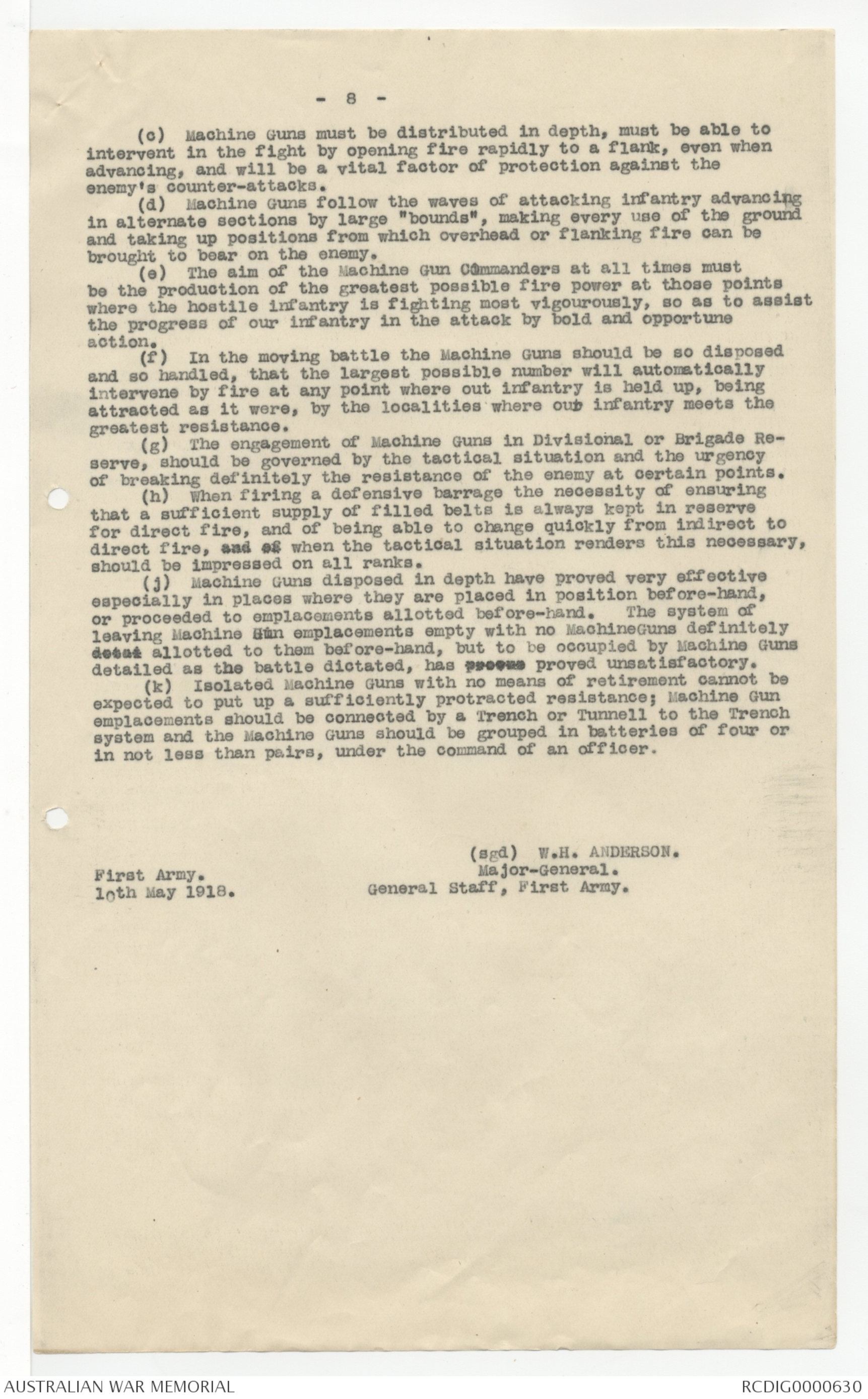
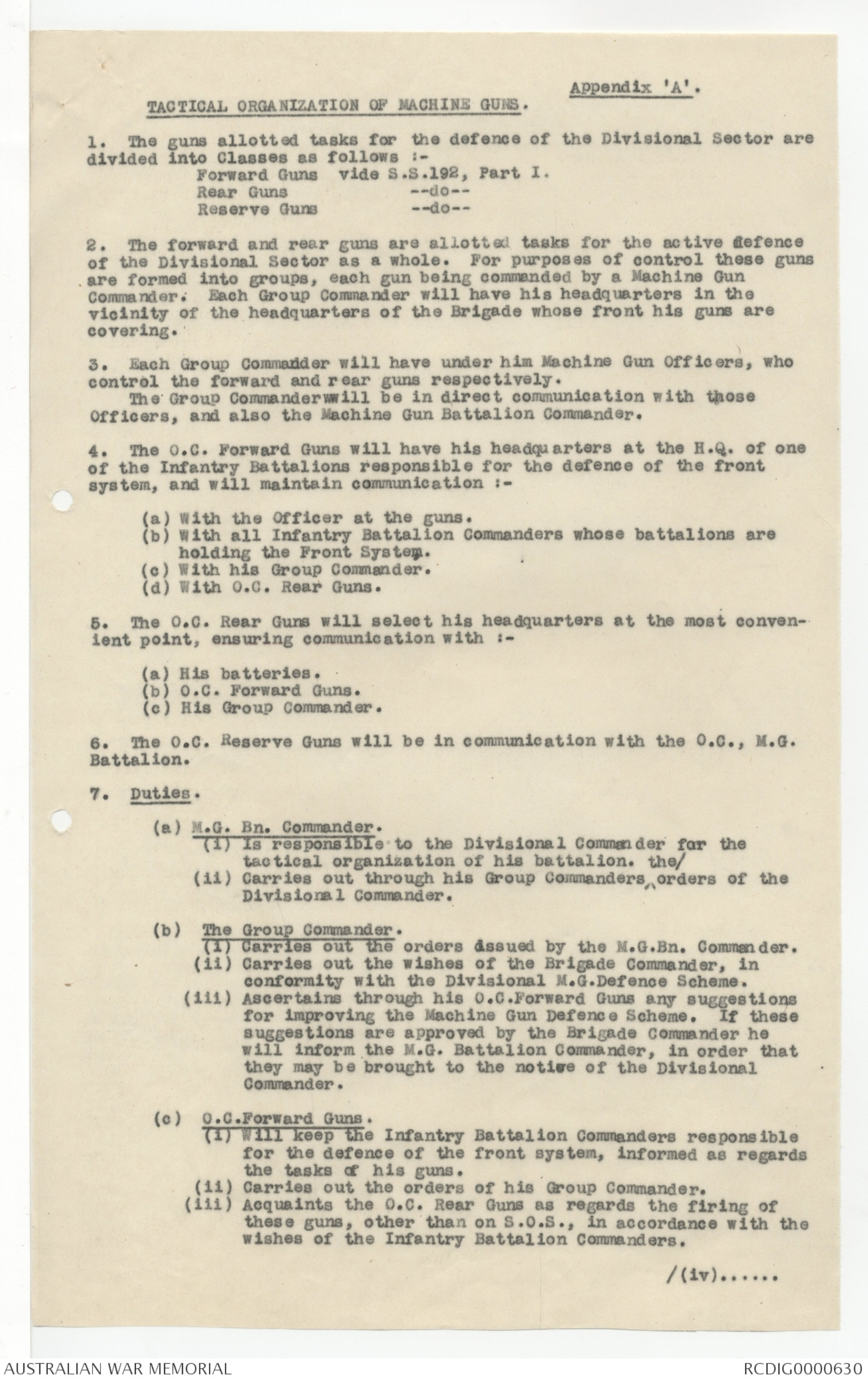
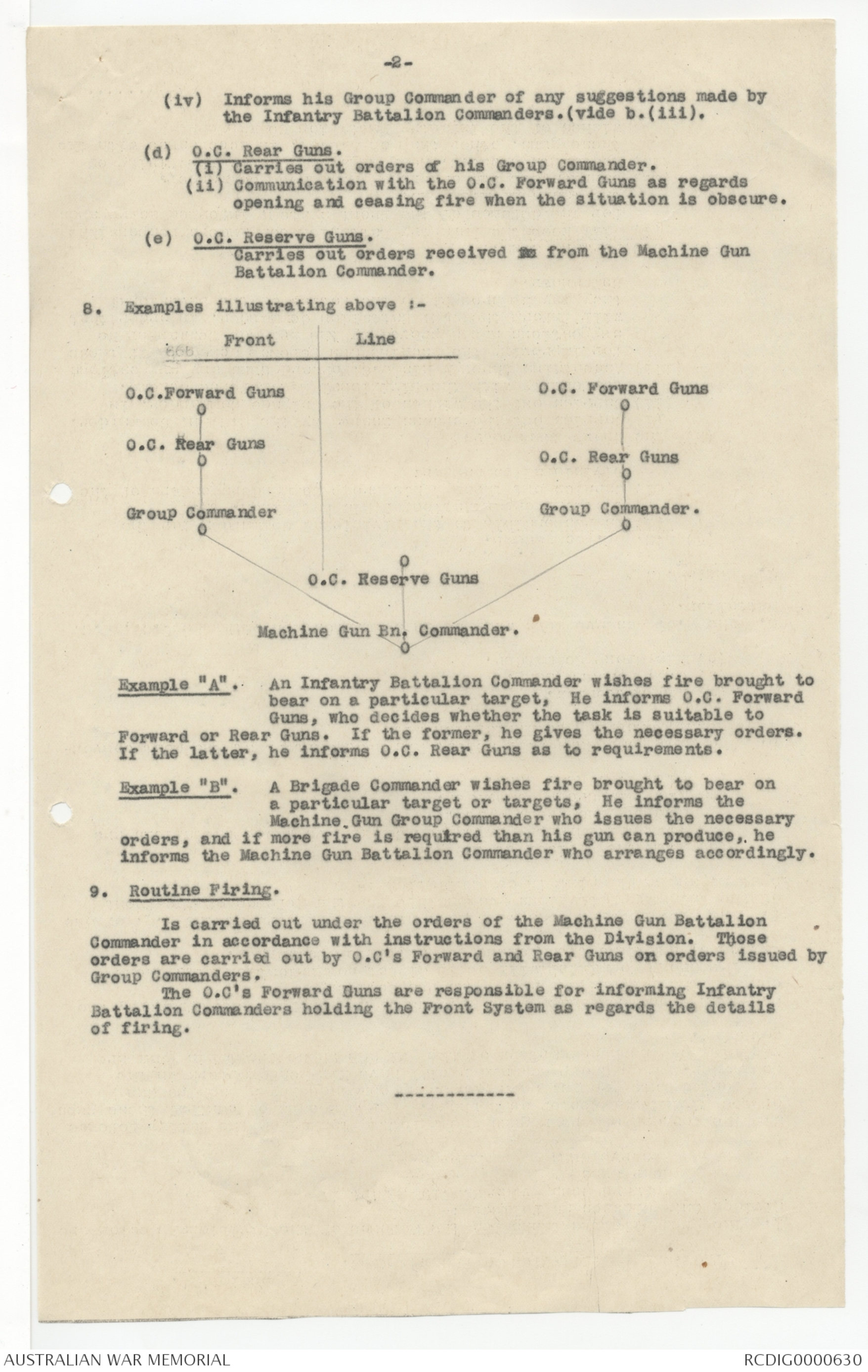

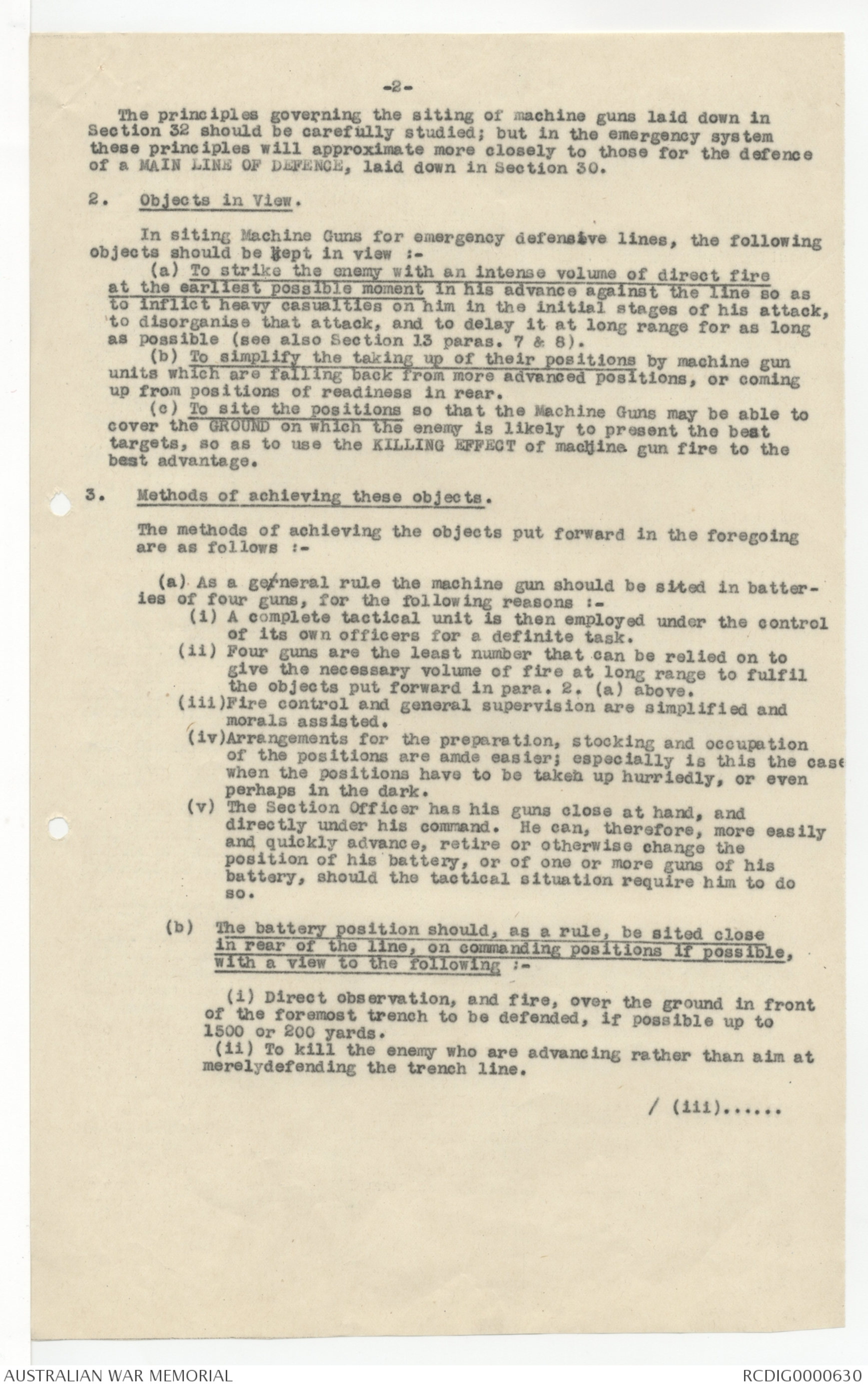
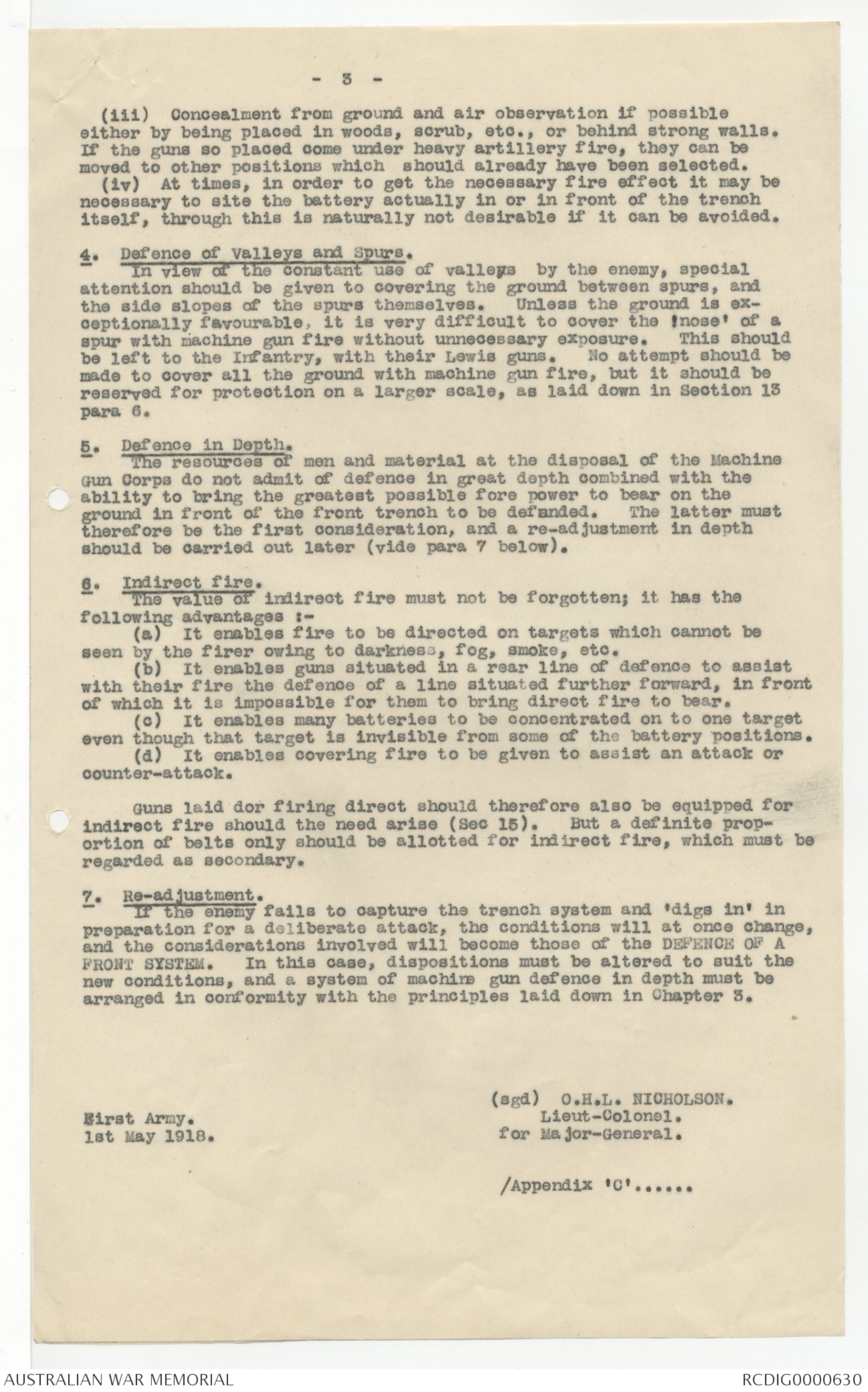
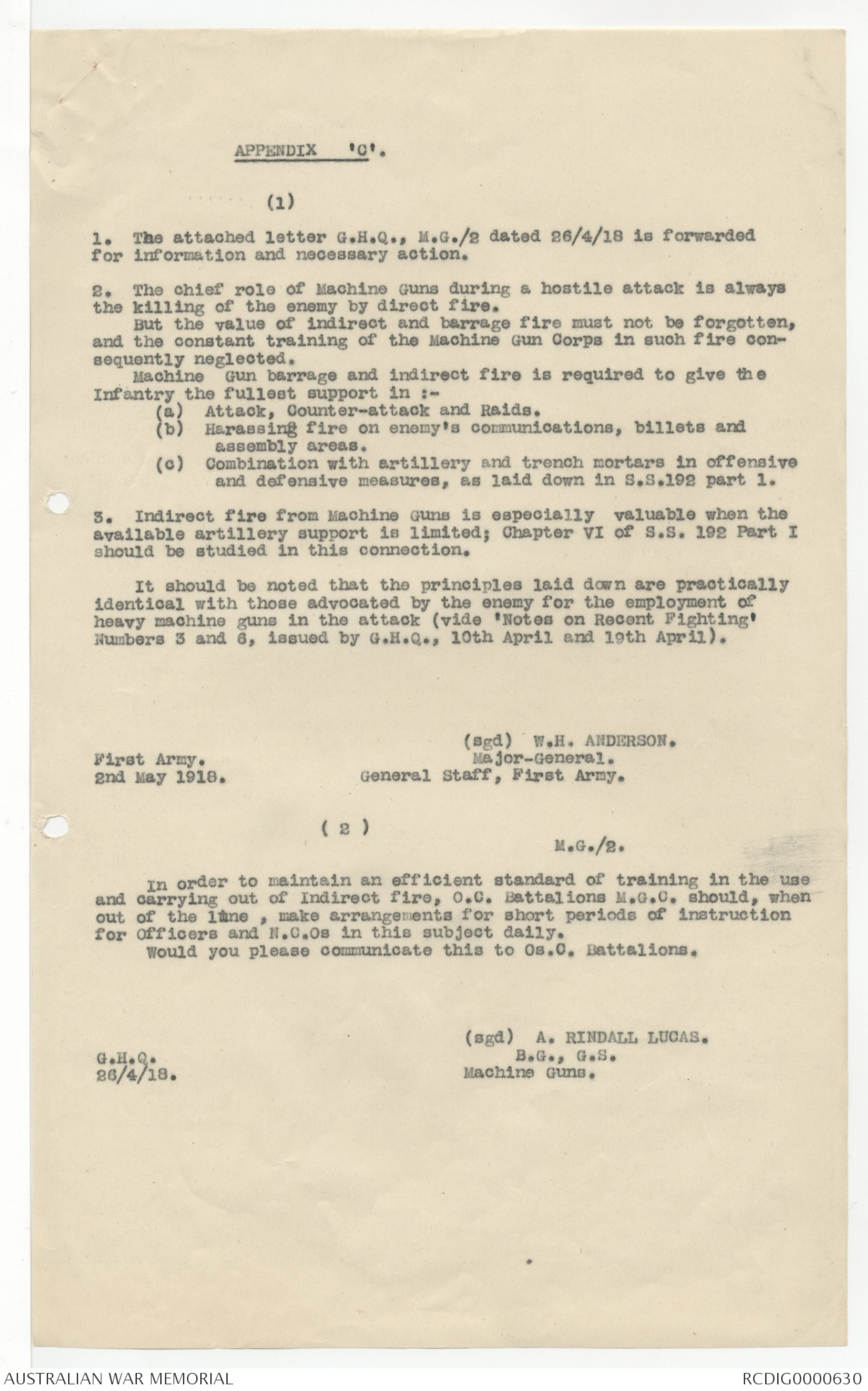

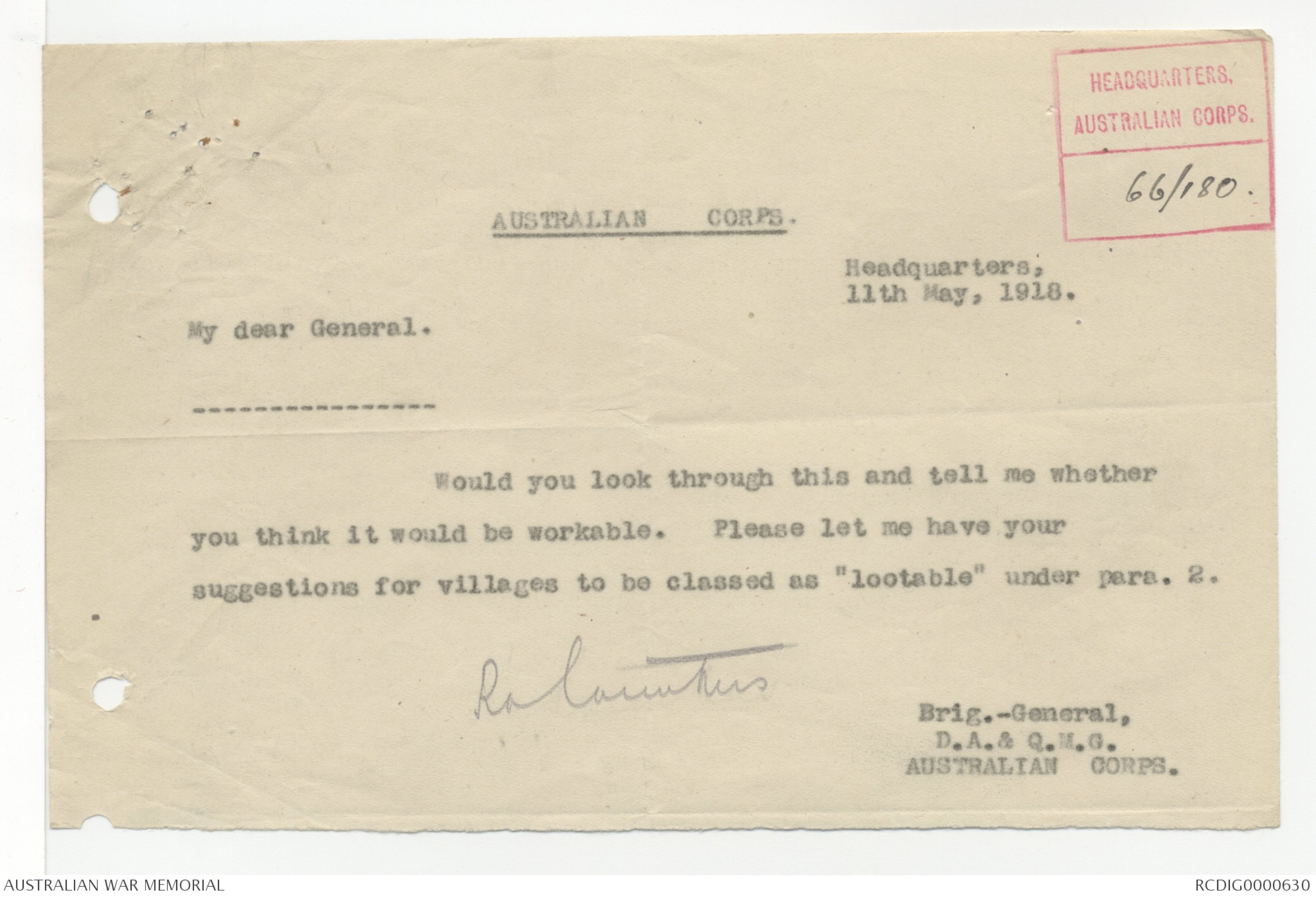

- 8 -
(c) Machine Guns must be distributed in depth, must be able to
intervent in the fight by opening fire rapidly to a flank, even when
advancing, and will be a vital factor of protection against the
enemy's counter-attacks.
(d) Machine Guns follow the waves of attacking infantry advancing
in alternate sections by large "bounds", making every use of the ground
and taking up positions from which overhead or flanking fire can be
brought to bear on the enemy.
(e) The aim of the Machine Gun Commanders at all times must
be the production of the greatest possible fire power at those points
where the hostile infantry is fighting most vigourously, so as to assist
the progress of our infantry in the attack by bold and opportune
action.
(f) In the moving battle the Machine Guns should be so disposed
and so handled, that the largest possible number will automatically
intervene by fire at any point where out infantry is held up, being
attracted as it were, by the localities where our infantry meets the
greatest resistance.
(g) The engagement of Machine Guns in Divisional or Brigade Reserve,
should be governed by the tactical situation and the urgency
of breaking definitely the resistance of the enemy at certain points.
(h) When firing a defensive barrage the necessity of ensuring
that a sufficient supply of filled belts is always kept in reserve
for direct fire, and of being able to change quickly from indirect to
direct fire, and as when the tactical situation renders this necessary,
should be impressed on all ranks.
(j) Machine Guns disposed in depth have proved very effective
especially in places where they are placed in position before-hand,
or proceeded to emplacements allotted before-hand. The system of
leaving Machine Gun emplacements empty with no MachineGuns definitely
detat allotted to them before-hand, but to be occupied by Machine Guns
detailed as the battle dictated, has xxxx proved unsatisfactory.
(k) Isolated Machine Guns with no means of retirement cannot be
expected to put up sufficiently protracted resistance; Machine Gun
emplacements should be connected by a Trench or Tunnell to the Trench
system and the Machine Guns should be grouped in batteries of four or
in not less than pairs, under the command of an officer.
(sgd) W.H. ANDERSON.
Major-General.
General Staff, First Army.
First Army.
10th May 1918.
Appendix 'A'.
TACTICAL ORANIZATION OF MACHINE GUNS.
1. The guns allotted tasks for the defence of the Divisional Sector are
divided into Classes as follows :-
Forward Guns vide S.S.192, Part 1.
Rear Guns --do--
Reserve Guns --do--
2. The forward and rear guns are allotted tasks for the active defence
of the Divisional Sector as a whole. For purposes of control these guns
are formed into groups, each gun being commanded by a Machine Gun
Commander. Each Group Commander will have his headquarters in the
vicinity of the headquarters of the Brigade whose front his guns are
covering.
3. Each Group Commander will have under his Machine Gun Officers, who
control the forward and rear guns respectively.
The Group Commanderwill be in direct communication with those
officers, and also the Machine Gun Battalion Commander.
4. The O.C. Forward Guns will have his headquarters at the H.Q. of one
of the Infantry Battalions responsible for the defence of the front
system, and will maintain communication :-
(a) With the Officer at the guns.
(b) With all Infantry Battalion Commanders whose battalions are
holding the Front System.
(c) With his Group Commander.
(d) With O.C. Rear Guns.
5. The O.C. Rear Guns will select his headquarters at the most
convenient point, ensuring communication with :-
(a) His batteries.
(b) O.C. Forward Guns.
(c) His Group Commander.
6. The O.C. Reserve Guns will be in communication with the O.C., M.G.
Battalion.
7. Duties.
(a) M.G. Bn. Commander.
(i) Is responsible to the Divisional Commander for the
tactical organization of his battalion.
(ii) Carries out through his Group Commanders ^the/ orders of the
Divisional Commander.
(b) The Group Commander.
(i) Carries out the orders issued by the M.G.Bn. Commander.
(ii) Carries out the wishes of the Brigade Commander, in
conformity with the Divisional M.G.Defence Scheme.
(iii) Ascertains through his O.C.Forward Guns any suggestions
for improving the Machine Gun Defence Scheme. If these
suggestions are approved by the Brigade Commander he
will inform the M.G. Battalion Commander, in order that
they may be brought to the notice of the Divisional
Commander.
(c) O.C.Forward Guns.
(i) Will keep the Infantry Battalion Commanders responsible
for the defence of the front system, informed as regards
the tasks of his guns.
(ii) Carries out the orders of his Group Commander.
(iii) Acquaints the O.C. Rear Guns as regard the firing of
these guns, other than on S.O.S., in accordance with the
wishes of the Infantry Battalion Commanders.
/(iv). . . . . .
-2-
(iv) Informs his Group Commander of any suggestions made by
the Infantry Battalion Commanders. (vide b. (iii).
(d) O.C. Rear Guns.
(i) Carries out orders of his Group Commander.
(ii) Communication with the O.C. Forward Guns as regards
opening and ceasing fire when the situation is obscure.
(e) O.C. Reserve Guns.
Carries out orders received xx from the Machine Gun
Battalion Commander.
8. Examples illustrating above :-
Front | Line
‾‾‾‾‾‾‾‾‾‾‾‾‾‾‾‾‾‾‾‾‾‾‾‾‾‾‾‾‾‾‾‾‾‾‾‾
O.C.Forward Guns | O.C. Forward Guns
o | o
| | |
O.C Rear Guns O.C. Rear Guns
o o
| |
Group Commander Group Commander.
o o
o
O.C Reserve Guns
Machine Gun Bn. Commander.
Example "A" . An Infantry Battalion Commander wishes fire brought to
bear on a particular target, He informs O.C. Forward
Guns, who decided whether the task is suitable to
Forward or Rear Guns. If the former, he gives the necessary orders.
If the latter, he informs O.C. Rear Guns as to requirements.
Example "B". A Brigade Commander wishes fire brought to bear on
a particular target or targets, He informs the
Machine Gun Group Commander who issues the necessary
orders, and if more fire is required than his gun can produce, he
informs the Machine Gun Battalion Commander who arranges accordingly.
9. Routine firing.
Is carried out under the orders of the Machine Gun Battalion
Commander in accordance with instructions from the Division. Those
orders are carried out by O.C.'s Forward and Rear Guns on orders issued by
Group Commanders.
The O.C.'s Forward Guns are responsible for informing Infantry
Battalion Commanders holding the Front System as regards the details
of firing.
APPENDIX B.
EMERGENCY SYSTEMS OF DEFENCE.
First Army
No.G.S.925/65.
1. Siting of Defences.
1. The emergency system of defence in the First Army rearward area
will be constructed on the principles given below. It must be realised
that the object of the emergency system is to prevent a break through
by German infantry who have penetrated our forward defences, possibly
supported by Field Artillery but before the Heavy Artillery can be
brought up; or acurate registration on the system carried out. Consequently
the amin object must be to obtain as good a field of fire as possible
and develop a maximum of rifle, Lewis gun and machine gun fire.
Time for constructing dug-outs and elaborate shelters will not be available,
but weather shelters should be made, where possible, for men and
S.A.A.
2. In undulating country.
The system should consist of :-
(a) A front line cited in front of the crest in order to obtain
observation.
(b) The support line 150 to 250 yards behind the front line sited
in front of the crest in order to obtain observation and to
bring as heavy rifle fire as is possible to bear.
(c) A reserve line, 400 to 500 yards behind the support line, and
sited, if possible, on the reverse slope and out of view of
the enemy, with at least 200 yards field of fire.
A system consisting of a single trench behind a belt of wire is
useless.
The whole system will be joined up by communication trenches designed
so that they can be used as switches. Special attention must be paid to
the defence and obstruction of valleys up which the enemy constantly
works in his advance.
If the enemy brings up heavy artillery, the reserve line, if on the
reverse slope will become the main line of resistance, provieded
artillery observation is available from the flanks orrear.
3. In the flat and enclosed country of FLANDERS. full use must be made
of every village, house, wood, hedge, piece of broken ground, ditch, etc.,
and advantage should be taken of the great possibilities this country
offers of concealing our defensive dispositions. The men must be taught
to realise the difference between the defence of houses, etc., before
the enemy has brought up guns, and when these are subject to Heavy
Artillery fire.
Lines of trenches or breastworks on the same principle as given in
para. 1. will be built as time permits. These lines should be flanked
and supported by fire from houses, woods etc, Streams, ditches and
enclosures must be wired to as to form distinct obstacles flanked by
fire from the defences.
11. Siting of Machine Gun Positions. (Note :- The references are to
S.S.192.- The employment of Machine Guns, Part 1. Tactical).
1.Principles.
The principles governing the siting of machine gun positions in
emergency systems differ materially from those laid down in S.S.192
Part 1. Chapter 111 of that publication deals definitely with the
FRONT SYSTEM of an elaborately prepared defensive position, when the
enemy is 'dug-in' and has had ample time for detailed observation
and for registration of heavy artillery and trench mortars. In this
case we are dealing with 'improvised defence' and Chapter VI must be
studied in this connection.
/The principles. . . . . .
-2-
The principles governing the siting of machine guns laid down in
Section 32 should be carefully studied; but in the emergency system
these principles will approximate more closely to those for the defence
of a MAIN LINE OF DEFENCE, laid down in section 30.
2. Objects in View.
In siting Machine Guns for emergency defensive lines, the following
objects should be kept in view :-
(a) To strike the enemy with an intense volume of direct fire
at the earliest possible moment in his advance against the line so as
to inflict heavy casualties on him in the initial stages of his attack,
to disorganise that attack, and to delay it at long range for as long
as possible (see also Section 13 paras. 7 & 8).
(b) To simplify the taking up of their positions by machine gun
units which are falling back from more advanced positions, or coming
up from positions of readiness in rear.
(c) To site the positions so that the Machine Guns may be able to
cover the GROUND on which the enemy is likely to present the best
targets, so as to use the KILLING EFFECT of machine gun fire to the
best advantage.
3. Methods of achieving the objects.
The methods of achieving the objects put forward in the foregoing
are as follows :-
(a) As a gerneral rule the machine gun should be sited in batteries
for four guns, for the following reasons : -
(i) A complete tactical unit is then employed under the control
of it own officers for a definite task.
(ii) Four guns are the least number that can be relied on to
give the necessary volume of fire at long range to fulfil
the objects put forward in para. 2. (a) above.
(iii) Fire control and general supervision are simplified and
morals assisted.
(iv) Arrangements for the preparation, stocking and occupation
of the positions are amde easier; especially is this the case
when the positions have to be taken up hurriedly, or even
perhaps in the dark.
(v) The Section Officer has his guns close at hand, and
directly under his command. He can, therefore, more easily
and quickly advance, retire or otherwise change the
position of his battery, or of one or more guns of his
battery, should the tactical situation require him to do
so.
(b) The battery position should, as a rule, be sited close
in rear of the line, on commanding positions if possible,
with a view to the following :-
(i) Direct observation, and fire, over the ground in front
of the foremost trench to be defended, if possible up to
1500 or 200 yards.
(ii) To kill the enemy who are advancing rather than aim at
merelydefending the trench line.
/ (iii). . . . . .
- 3 -
(iii) concealment from ground and air observation if possible
either by being placed in woods, scrub, etc., or behind strong walls.
If the guns so placed come under heavy artillery fire, they can be
moved to other positions which should already have been selected.
(iv) At times, in order to get the necessary fire effect it may be
necessary to site the battery actually in or in front of the trench
itself, through this is naturally not desirable if it can be avoided.
4. Defence of Valleys and Spurs.
In view of the constant use of valleys by the enemy, special
attention should be given to covering the ground between spurs, and
the side slopes of the spurs themselves. Unless the ground is exceptionally
favourable, it is very difficult to cover the 'nose' of a
spur with machine gun fire without unnecessary exposure. This should
be left to the Infantry, with their Lewis guns. No attempt should be
made to cover all the ground with machine gun fire, but it should be
reserved for protection on a larger scale, as laid down in Section 13
para 6.
5. Defence in Depth.
The resources of men and material at the disposal of the Machine
Gun Corps do not admit of defence in great depth combined with the
ability to bring the greatest possible fore power to bear on the
ground in front of the front trench to be defended. The latter must
therefore be the first consideration, and a re-adjustment in depth
should be carried out later (vide para 7 below).
6. Indirect fire.
The value of indirect fire must not be forgotten; it has the
following advantages :-
(a) It enables fire to be directed on targets which cannot be
seen by the firer owing to darkness, fog, smoke, etc.
(b) It enables guns situated in a rear line of defence to assist
with their fire the defence of a line situated further forward, in front
of which it is impossible for them to bring direct fire to bear.
(c) It enables many batteries to be concentrated on to one target
even though that target is invisible from some of the battery positions.
(d) It enables covering fire to be given to assist an attack or
counter-attack.
Guns laid dor firing direct should therefore also be equipped for
indirect fire should the need arise (Sec 15). But a definite proportion
of belts only should be allotted for indirect fire, which must be
regarded as secondary.
7. Re-adjustment.
If the enemy fails to capture the trench system and 'digs in' in
preparation for the deliberate attack, the conditions will at once change,
and the considerations involved will become those of the DEFENCE OF A
FRONT SYSTEM. In this case, dispositions must be altered to suit the
new conditions, and a system of machine gun defence in depth must be
arranged in conformity with the principles laid down in Chapter 3.
(sgd) O.H.L. NICHOLSON.
Lieut-Colonel.
for Major-General.
First Army.
1st May 1918
/Appendix "C". . . . . .
APPENDIX 'C'.
(1)
1. The attached letter G.H.Q., M.G./2 dated 26/4/18 is forwarded
for information and necessary action.
2. The chief role of Machine Guns during a hostile attack is always
the killing of the enemy by direct fire.
But the value of indirect and barrage fire must not be forgotten,
and the constant training of the Machine Gun Corps in such fire consequently
neglected.
Machine Gun barrage and indirect fire required to give the
Infantry the fullest support in : -
(a) Attack, Counter-attack and Raids.
(b) Harassing fire on enemy's communications, billets and
assembly areas.
(c) Combination with artillery and trench mortars in offensive
and defensive measures, as laid down in S.S.192 Part 1.
3. Indirect fire from Machine Guns is especially valuable when the
available artillery support is limited; Chapter VI of S.S. 192 Part 1
should be studied in this connection.
It should be noted that the principles laid down are practically
identical with those advocated by the enemy for the employment of
heavy machine guns in the attack (vide 'Notes on Recent Fighting'
Numbers 3 and 6, issued by G.H.Q., 10th and 19th April).
(sgd) W.H. ANDERSON.
Major-General.
General Staff, First Army.
First Army.
2nd May 1918.
(2)
M.G./2.
In order to maintain an efficient standard of training in the use
and carrying out of Indirect fire, O.C. Battalions M.G.C. should, when
out of the line, make arrangements for short periods of instruction
for Officers and N.C.Os in this subject daily.
Would you please communicate this to Os.C. Battalions.
(sgd) A. RINDALL LUCAS.
B.G., G.S.
Machine Guns.
G.H.Q.
26/4/18.
11/5/18
G.O.C.
Capt C.A.Pyke Record of Divisional Work.
(1) Apptd. Camel Transport Officer 13.5.16.
(Serapeum)
(2) Acting D A Q M G. 4th. Aus. Divn. 26.5.16 - 14.6.16.
(3) Attached Q. 4th Aus Divn. 15.6.16 - 28.7.16
(4) Appointed D A Q M G. 3rd Aus. Div. 5.8.16.
(5) " D A A G. " 4.9.17.
[*Only D.A.A.G
who is a Capt.*]
[*Several cases of
junior in A.S.C
in Egypt pass over*]
[*100's in A.I.F. & in non-Compt.*]
[*A.P.M.
D.A.D.M.S.*]
officers senior as captains in A.A.S.C.
(Pyke's. substantive captaincy dates 15.10.15)
Temp Capt Oct 1/15
Capt W.O. Stevenson 1st Div Train
" C. Reynolds 4th Div. Train dud
" S. Walker 2nd Div. Train. ? dud
" S.A. Robertson 4th Div. Train good. - outdated
Pyke Capt before
he left
It is essential that the DAAG. of the Division should
be of field rank in order to give him status
in his dealings with field officers. The A.P.M. who
comes directly under him as a 'Major
11/5/18
REJ
Lt Col.
HEADQUARTERS
AUSTRALIAN CORPS
66/180
AUSTRALIAN CORPS .
Headquarters,
11th May, 1918.
My dear General.
Would you look through this and tell me whether
you think it would be workable. Please let me have your
suggestions for villages to be classed as "lootable" under para. 2.
R A Carruthers
Brig.-General,
D.A.& Q.M.G.
AUSTRALIAN CORPS.
THIRD AUSTRALIAN DIVISION.
Divisional Headquarters,
11th. May, 1918. -
T O :-
THE OFFICERS AND MEN of the
THIRD AUSTRALIAN DIVISION. -
In publishing the accompanying appeal of the Mayor
and farmers of the Commune of BUSSY-les-DAOURS, I fully recognise
the difficulties, especially in areas from which the French inhabitants
have been evacuated; but I look to every officer and man of
the Division to do everything that is possible to help the poor unfortunate
French people in the troubles which have befallen them. -
The last thing any member of this Division would wish
to see is that the misfortunes of the French peasantry should be
aggravated by our carelessness or indifference. - I prefer to
appeal to the feelings of humanity and sympathy of the Australian
troops towards the unhappy French population, rather than to issue
disciplinary instructions on this matter. . .
I have sufficient confidence in the good feeling of
the troops to believe that such an appeal will influence them much
more strongly than any threat of disciplinary action. -
John Monash
Major-General.-
Commanding, Third Australian Division.
(WEB).
 Sam scott
Sam scottThis transcription item is now locked to you for editing. To release the lock either Save your changes or Cancel.
This lock will be automatically released after 60 minutes of inactivity.